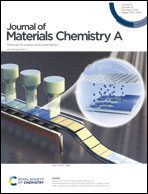Stable bismuth phosphosulfide nanoparticle encapsulation into hollow multi-channel carbon nanofibers toward high performance sodium storage†
Abstract
Searching for suitable and efficient anode materials is one of the crucial prerequisites for the successful large-scale application of sodium ion batteries (SIBs). In this work, a facile strategy is proposed to encapsulate bismuth phosphosulfide nanoparticles within hollow multi-channel carbon nanofibers (BiPS4@MCNFs) for remarkably enhancing the sodium storage properties. The synergistic effect between the highly dispersed BiPS4 nanoparticles and the multi-channel hollow carbon matrix can effectively improve the utilization of the active materials, alleviate the volume changes and promote mass/charge transfer, thereby resulting in outstanding cycling stability (about 410 mA h g−1 after 1000 cycles at 1 A g−1) and high rate performance. Both the sodium storage mechanism and its potential as the sodium host in full cells are further investigated. Furthermore, the sodium diffusion coefficient has also been analyzed and the three-dimensional (3D) sodium ion diffusion pathways are identified via first-principles calculations. These results demonstrate that the unique BiPS4@MCNFs could be a competitive candidate anode for SIBs.



 Please wait while we load your content...
Please wait while we load your content...